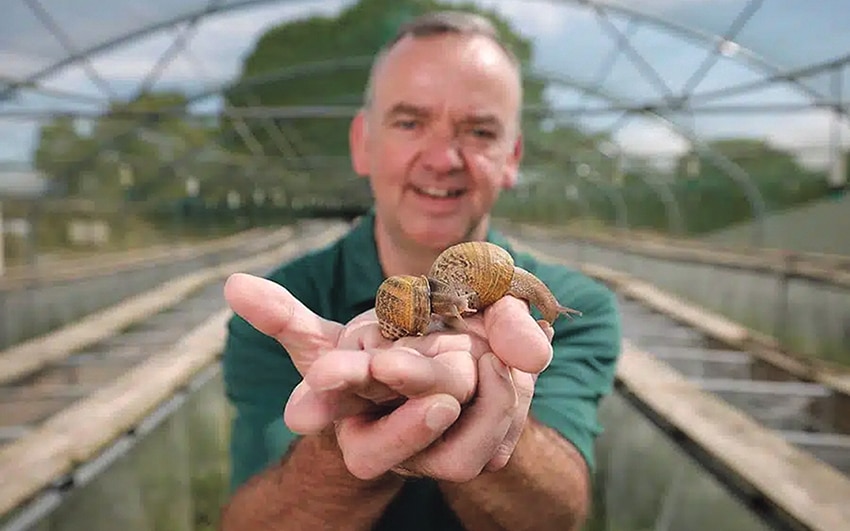
Do you suffer from intense dry skin conditions like Psoriasis or Eczema? Are you searching for something to soothe and heal your skin? If so, you might be interested in a new range of skincare products we’ve recently started stocking. These products contain an unusual yet powerful ingredient: snail mucin, commonly known as snail slime.
You might be wondering, “Why would I want to put snail slime on my skin? Doesn’t it feel or smell strange? And why is Organico stocking something like this?”
Let’s start with the last question. We decided to stock the Bragan Skincare range because deeply dry skin conditions are notoriously difficult to treat. When I heard about this range, I knew we had to give it a try. It appears to be one of the most effective ways to deeply moisturise and heal conditions like psoriasis and eczema. Plus, it’s produced by an Irish company using a state-of-the-art cosmetics production facility in Italy.
This revolutionary product is the brainchild of Kieran Corley, the founder of Bragan Skincare. While driving home from work he heard a segment on the radio about snail farming. Intrigued, he spent time researching the topic and enrolled in several online courses. When the lockdown hit, Kieran had plenty of time to dedicate to his newfound fascination, eventually setting up his own snail farm in Co. Monaghan to supply French Restaurants with Escargot. He began with 50,000 breeder snails, sourced from a farmer in Co. Carlow.
After farming the snails for some time, Kieran noticed a marked improvement in his skin and the blemishes on his arms and hands, accumulated over 50 years of life’s adventures, had almost disappeared. This discovery excited and inspired Kieran and his wife, Marion, to start experimenting with snail slime lotions and potions at their kitchen table. Their first guinea pig was their daughter’s boyfriend, who suffered from severe psoriasis on his arms. After about four weeks of treatment using their kitchen prototype, his psoriasis was virtually gone.
Friends, family, and neighbours with skin conditions were soon persuaded to try this new concoction. Many reported unbelievable healing results. Word spread, and soon strangers were knocking on the door, asking for ‘The Snail Man’ and some of the ‘snail stuff’. Babies who had tried everything from dermatologists, chemists, and doctors saw their eczema clear up in as little as five days. Older ladies suffering from stretch marks after shingles found relief and regained mobility after using the product.
Today, Bragan Skincare has over one million snails at their farm in Co. Monaghan. Kieran is very proud of his proprietary harvesting method – his company harvests the snails’ mucin two to three times a year, using a process that doesn’t harm the snails. This is in stark contrast to many of the Korean products that simply blend the whole snail, giving a diluted product and a less sustainable process.
So, what is the science behind all this? It turns out that snail slime has been used in the medical field for wound healing, surgical glue, and even to combat gastric ulcers for years.
More recently, snail mucin has become a buzzword in the skincare industry, largely thanks to its popularity in Korean beauty products and celebrity proponents of the treatment. While it may sound a bit icky, using snail slime in skincare has ancient roots. And recently, it’s remarkable ability to improve skin texture, reduce fine lines, and hydrate the skin has gained global recognition. But what exactly makes this extraordinary ingredient so effective?
A study published in the ‘Molecules’ journal explains that snails secrete a slime or mucus to protect their foot — a significant part of their body — from injury, bacteria, and UV rays. This secretion, which has a very low pH, aids in their movement, feeding, and defence against predators. Snail slime contains a powerful mix of antioxidants, anti-inflammatories, and pro-regenerative components, including allantoin, glycolic acid, elastin, collagen, and mucin-like glycoprotein complexes. These compounds provide various skin benefits, from sun protection and exfoliation to deep moisturising.
Allantoin helps heal, soothe, and smooth the skin. Collagen, present in connective tissue, skin, tendons, bones, and cartilage, provides structural support and plays a crucial role in tissue repair. As we age, collagen levels decline, leading to fine lines and wrinkles. Glycolic acid stimulates cell renewal, reducing dark spots and hyperpigmentation for an even skin tone.
For Psoriasis and Eczema we recommend the Bragan Skincare Atopic Cream. Fragrance-free, itch-free, and skin-repairing, it comes in a 50ml pump action dispenser. The Atopic Cream is the best cream for atopic dermatitis, eczema, psoriasis, dry skin, skin rashes, stretch marks, or scar tissue.
Key ingredients: The Atopic Cream is rich in Allantoin, Collagen, Elastin, Glycolic Acid, Hyaluronic Acid, Lactic Acid, Mucopolysaccharides, Vitamins A-C-E-B1-B6.
They also make a range of other products including a Scalp Sooth for scalp psoriasis, a non-irritating shampoo, a cream for Restless Legs, a hand cream and a beauty cream for mature skin.
The only thing to be aware of is that snails are mollusks so if you have a shellfish allergy this product may not suit you. We have shelf testers in our shop in Bantry if you’d like to do a patch test. Otherwise, we have these creams online at www.organico.ie.
Need advice? Why not call in?
If you’d like more information on healing extremely dry skin conditions through diet and lifestyle, call in to us in Organico and we will help you make some positive changes. It’s never too late to start. Or if you are not local to us, drop us an email on online@organico.ie and we will do our best to advise you.



